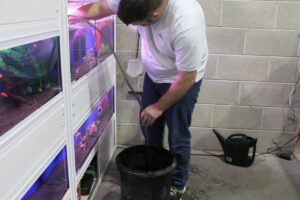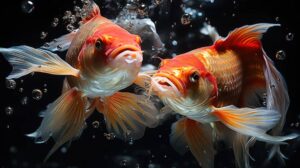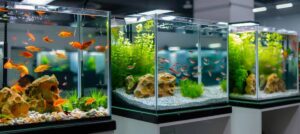The Pets Care Blog

Basics of Aquascaping: Layouts and Hardscape Ideas for Beginners
Aquascaping is where the science of aquariums meets the art of design. It’s more than just decorating your tank — it’s about building a vibrant underwater landscape where your fish feel at home, plants flourish, and every element has a purpose.
But if you’re new to the world of planted tanks and carefully crafted rock formations, it can feel overwhelming. What should go where? Do you need fancy equipment? And how do aquascapers get their tanks to look like miniature riverbeds or forest floors?
This guide will help you understand the basics of aquascaping, offering practical aquascaping tips, layout strategies, and inspiration for your beginner fish tank décor. Whether you want a lush jungle look, a zen rockscape, or just something better than a plastic castle and gravel, this article will walk you through everything you need to create a beautiful, balanced underwater scene.
What is Aquascaping?
Aquascaping is the art of arranging aquatic plants, stones, driftwood, and substrate in an aquarium in a way that mimics natural environments or artistic styles. It’s not just about looks — a good aquascape also supports fish health and water quality.
Why Aquascape?
- Aesthetic appeal — transforms your tank into a natural masterpiece
- Healthy ecosystem — live plants help control nitrates and oxygen levels
- Enrichment — provides hiding spots, territory, and exploration areas for fish
- Personal expression — create a layout that reflects your taste and style
It’s like interior decorating — but for fish.
Core Elements of Aquascaping
Before diving into layouts, you’ll want to understand the building blocks of a successful aquascape.
1. Substrate
This is the base layer that anchors plants and affects water chemistry.
- Inert substrates (like sand or gravel) Good for hardscape-focused tanks
- Nutrient-rich soils Ideal for planted aquariums
Use finer substrates in the front and coarser ones in the back for depth perception.
2. Hardscape
Hardscape refers to non-living materials used to structure the layout.
- Rocks (Seiryu, Dragon stone, Lava rock)
- Wood (Spider wood, Mopani, Driftwood)
- Caves or slates for hiding spots
These elements create the “bones” of your layout.
3. Plants
Plants add softness, colour, and biological filtration. Start with hardy species like.
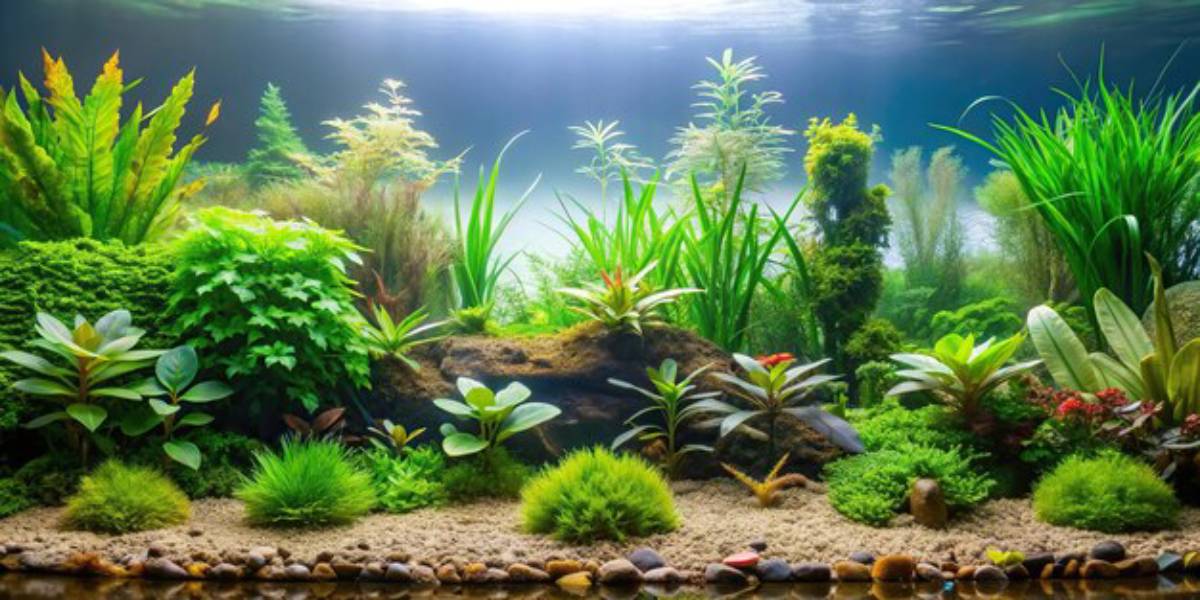
- Java Fern
- Anubias
- Amazon Sword
- Vallisneria
- Cryptocoryne
Use taller plants in the back and low-growers like moss or carpeting plants in the foreground.
4. Lighting
Essential for plant growth and visual balance. Opt for full-spectrum LEDs with timers for consistent lighting cycles.
Popular Aquascaping Layout Styles
Knowing what layout to aim for makes planning easier and helps you avoid a cluttered or chaotic tank. Here are three beginner-friendly layout types.
1. Nature Style (Inspired by Takashi Amano)
- Mimics natural landscapes (forests, mountains, meadows)
- Asymmetrical design
- Encourages plant and fish harmony
Ideal for: Beginners looking for a serene, plant-forward look.
2. Iwagumi (Rock-Focused Minimalism)
- Based on Japanese Zen aesthetics
- Minimal plants, focus on stone placement
- Uses odd numbers of rocks (e.g. 3, 5, or 7)
Ideal for: Aquarists who prefer a structured, calming design.
3. Dutch Style
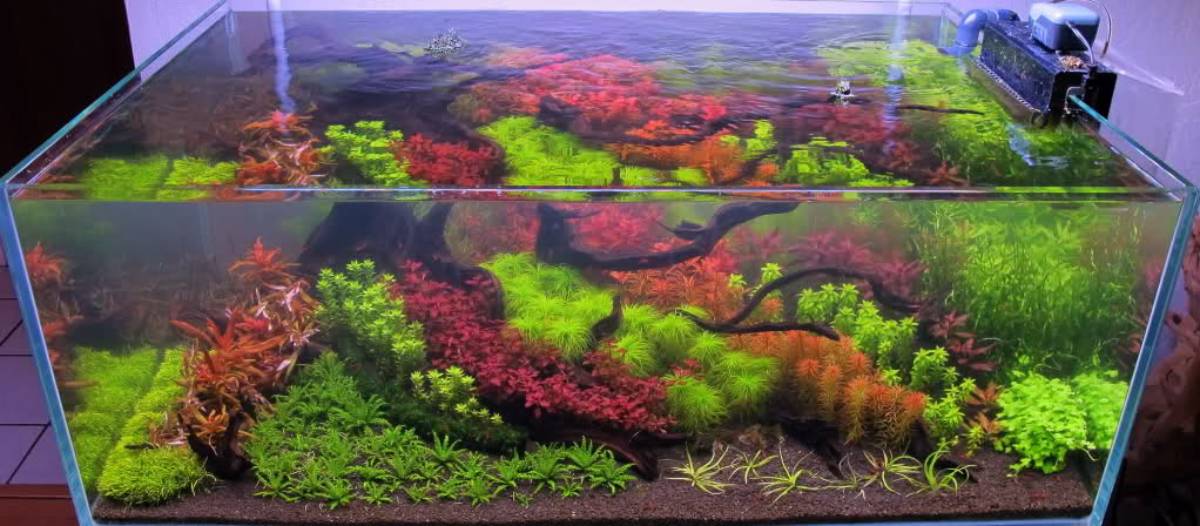
- No hardscape; plant-focused
- Emphasises colour, texture, and contrast
- Layer the plants like a garden
Ideal for: Hobbyists interested in plant variety and lush displays.
Planning Your Aquarium Layout
Planning ahead will save you from mid-tank regrets or frequent re-scapes. Follow these layout principles for balance and flow.
Use the Rule of Thirds
Imagine a grid dividing your tank into nine sections. Place your focal point (a tall plant, striking rock, or wood piece) along one of the vertical lines, rather than dead centre.
Create Depth
- Slope the substrate from back to front
- Place taller plants and rocks at the rear and smaller elements in front
- Use mid-ground pieces to create transitions
Leave Open Space
Open swimming zones make your tank feel more spacious and allow fish to move freely.
Balance Hard and Soft Elements
Contrast sharp rock edges with flowing plants or mosses to create visual harmony.
Easy Hardscape Ideas for Beginners
You don’t need expensive imported stone to create a beautiful tank. Try these beginner-friendly hardscape concepts.
1. Wood & Stone Combo
Place a large piece of driftwood at a 45-degree angle with smaller stones at its base, like tree roots spreading through soil.
2. Island Layout
Create a raised centre island of stone and plants surrounded by open sand, which mimics riverbank terrain.
3. Ridge & Valley
Use a sloped hill of substrate with rocks cascading down one side to mimic mountain ridges or river valleys.
4. Rock Garden
Use three to five rocks of varying sizes grouped asymmetrically with short plants around them. Simpler than Iwagumi but equally striking.
Remember to test all hardscape materials for aquarium safety — avoid sharp edges, non-aquarium safe woods, or limestone that may affect pH.
Tools to Help You Aquascape Like a Pro
You don’t need a full studio setup, but a few basic tools will make the process easier.
- Aquascaping tweezers and scissors for plant handling
- Aquarium-safe glue or thread to attach moss or ferns to wood
- Planting sticks to help with deep or awkward planting areas
- Siphon or turkey baster for gently clearing debris from décor
A spray bottle with water helps keep plants moist during layout planning (especially useful if you’re doing a dry start).
Tips for Long-Term Aquascaping Success
Aquascaping is a living art — it evolves. Here’s how to keep your creation thriving.
- Trim plants regularly to maintain shape and prevent overgrowth
- Avoid overloading the foreground — keep viewing lines open
- Don’t add all your décor at once — leave space to grow into it
- Test water parameters weekly to ensure stable conditions
- Let your layout mature — it may take weeks to “fill in” properly
Most importantly, be patient. Even pro aquascapers tweak and evolve their tanks over time. If you’re unsure where to start, consider choosing plants for a low-maintenance tank to keep your aquascape manageable as it matures.
Common Mistakes to Avoid
It’s easy to get carried away or make simple errors that impact your aquascape. Keep an eye out for these beginner blunders.
- Too much symmetry — nature is rarely perfectly balanced
- Flat layouts — avoid placing all elements at the same height
- Mixing incompatible plant needs (e.g., light vs low-light species)
- Ignoring fish needs — some species prefer hiding spots or open space
- Overcrowding with decorations — less is often more
When in doubt, simplify. Focus on one strong feature and build your layout around it.
Before finalising your design, consider arranging décor for fish safety and aesthetics to avoid sharp edges or layouts that stress fish behaviour.
Conclusion: Design with Purpose, Build with Patience
Aquascaping transforms a plain glass box into a world of movement, depth, and beauty. But it’s not just about looks — thoughtful layout and hardscape planning help you build a healthy, low-stress environment for your fish and plants.
Whether you’re drawn to minimalist rockscapes, lush underwater jungles, or balanced riverbeds, remember to plan your space, select hardy materials, and give your setup time to evolve. The best aquascapes are those that feel alive, not forced.
Feeling inspired to start? Sketch out your dream layout, explore some local hardscape options, and start with a few beginner-friendly plants. Share your first aquascape in the comments — we’d love to see what you create!




